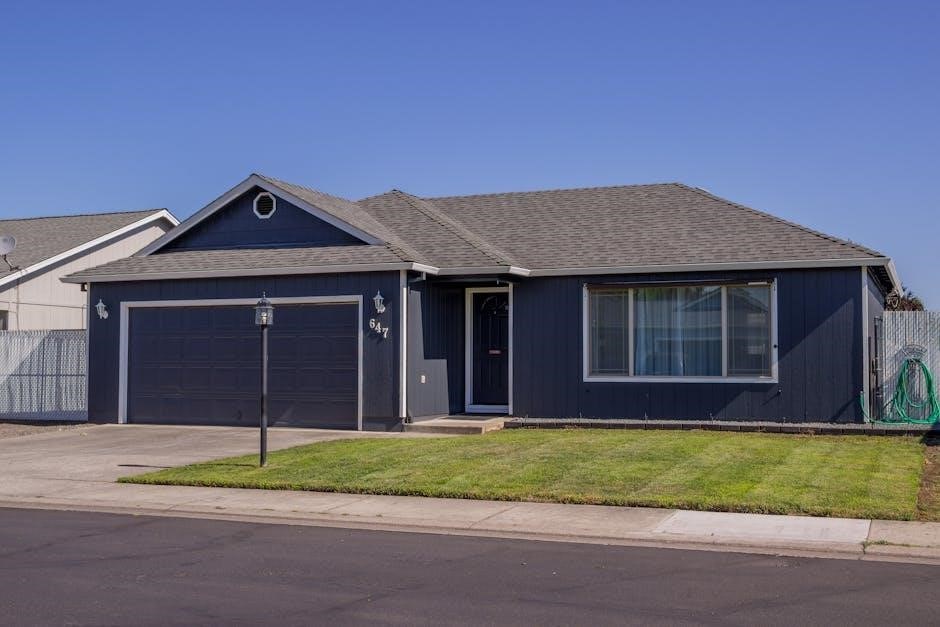This guide provides a comprehensive resource for addressing common issues with Genie garage door openers, ensuring smooth operation and optimal performance through effective troubleshooting and maintenance strategies.
1.1 Understanding the Importance of Regular Maintenance
Regular maintenance is crucial for ensuring the optimal performance and longevity of your Genie garage door opener. By addressing minor issues early, you can prevent them from escalating into major repairs. Proper upkeep, such as lubricating moving parts and cleaning sensors, helps maintain smooth operation and safety. Regular inspections can identify worn components, like springs or rollers, before they fail. A well-maintained system not only enhances reliability but also contributes to the overall security and convenience of your home. Consistent care ensures your garage door opener functions efficiently, reducing the risk of unexpected breakdowns and prolonging its lifespan.
1.2 Overview of Common Issues and Solutions
Common issues with Genie garage door openers include doors that won’t open or close, malfunctioning remote controls, misaligned sensors, and unusual noises. These problems often stem from simple causes like power outages, dead batteries, or sensor obstruction. Solutions typically involve checking power sources, replacing batteries, cleaning sensors, or lubricating moving parts. For more complex issues, such as motor malfunctions, professional assistance may be necessary. Addressing these problems promptly can prevent further damage and ensure reliable operation. This guide provides step-by-step solutions to help you resolve these issues efficiently and maintain your garage door opener’s performance.

Common Issues with Genie Garage Door Openers
Genie garage door openers may experience issues like door malfunctions, sensor misalignment, or unusual noises. Regular maintenance and prompt troubleshooting can address these problems effectively.

2.1 Door Won’t Open or Close
If your Genie garage door won’t open or close, first check the power source and ensure the opener is plugged in. Verify that the circuit breaker hasn’t tripped. Next, inspect the safety sensors for proper alignment and cleanliness, as misalignment or blockages can prevent operation. Check for any obstructions on the door tracks. Ensure the door is balanced and springs are in good condition, as an unbalanced door can strain the opener. If issues persist, try resetting the opener or consulting a professional for internal component inspection.
2.2 Remote Control Not Functioning
If your Genie garage door opener’s remote control isn’t working, start by checking the batteries. Replace them with fresh ones to ensure proper functionality. Next, inspect the remote for any visible damage or wear. Ensure the remote is programmed correctly to the opener by following the manufacturer’s instructions. Check for signal interference from nearby devices. If issues persist, try resetting the remote or reprogramming it. Additionally, verify that the wall console and motor unit are functioning properly. If the problem remains unresolved, consider consulting a professional or replacing the remote.
2.3 Sensor Misalignment or Malfunction
Sensor misalignment or malfunction is a common issue with Genie garage door openers. Start by checking the sensors located near the floor on both sides of the door. Ensure they are clean and free from debris, as dirt or obstructions can disrupt their infrared beam. Verify that the sensors are properly aligned and their LED lights are on. If the lights are off or blinking, misalignment is likely. Gently adjust the sensors to ensure they face each other directly. If the issue persists, test the door’s operation to confirm proper alignment. Regularly cleaning and aligning these sensors can prevent future malfunctions.
2.4 Unusual Noise or Vibration
Unusual noise or vibration in your Genie garage door opener can indicate worn or loose components. Start by inspecting the chain or belt for wear and tear. Lubricate moving parts, such as rollers and hinges, to reduce friction and noise. Check for loose screws or bolts on the rail or motor unit and tighten them securely. If the noise persists, it may signal worn springs or gears, which require professional attention. Regular lubrication and inspections can help prevent excessive noise and ensure smooth operation. Addressing these issues promptly will maintain the longevity and performance of your garage door opener.
Essential Maintenance Tips for Genie Garage Door Openers
Regular lubrication of moving parts, such as rollers and hinges, ensures smooth operation; Cleaning safety sensors and checking door springs for wear can prevent unexpected issues and extend longevity.
3.1 Lubricating Moving Parts
Lubricating the moving parts of your Genie garage door opener is crucial for maintaining smooth operation; Regularly apply a silicone-based lubricant to rollers, hinges, and springs to reduce friction and wear. Avoid using grease or oil, as they can attract dust and dirt, leading to premature wear. Lubrication should be done every 6–12 months, depending on usage. Proper lubrication ensures quiet operation, prevents mechanical strain, and extends the lifespan of your garage door opener. This simple maintenance step can help avoid costly repairs and keep your system running efficiently year-round.
3.2 Cleaning and Aligning Safety Sensors
Cleaning and aligning safety sensors are critical for ensuring your Genie garage door opener operates safely and efficiently. Over time, dirt, dust, or debris can accumulate on the sensors, causing misalignment or malfunction. Use a soft cloth to gently wipe the sensors, ensuring they are free from obstructions. Next, check the alignment by verifying that the infrared beams are properly aligned and unobstructed. If misaligned, adjust the sensors slightly until the lights indicate proper alignment. Regular cleaning and alignment prevent accidents and ensure the door opens and closes smoothly. This maintenance step is essential for reliable performance and safety.
3.3 Checking and Replacing Worn-Out Springs
Garage door springs play a crucial role in counterbalancing the weight of the door. Over time, springs can wear out, causing uneven operation or complete failure. To check for worn-out springs, inspect for visible signs of damage, such as fraying or gaps between coils. Measure the spring tension by gently lifting the door; if it feels heavy or unbalanced, the springs may need replacement. Always disconnect power before attempting spring adjustments. Replacing worn-out springs requires precision to ensure proper tension and safety. If unsure, consider consulting a professional technician to avoid accidents and ensure the door operates smoothly and safely.

Troubleshooting Guide for Specific Genie Models

This section provides model-specific troubleshooting solutions for Genie garage door openers, helping you diagnose and repair issues unique to your particular model efficiently and safely.
4.1 Genie ChainLift 600 (Model 1022)
The Genie ChainLift 600 (Model 1022) is a reliable chain-drive opener, but common issues include the door not opening, sensor misalignment, and remote malfunctions. To troubleshoot, first check the chain for proper tension and lubrication. Ensure safety sensors are aligned and free from obstructions. If the remote isn’t working, replace batteries or reprogram it. For door movement issues, inspect the door balance and springs. Refer to the Powerhead LED lights for diagnostic cues, as they indicate specific error codes. Regularly lubricating moving parts and ensuring all components are securely fastened can prevent many problems. Always consult the manual for model-specific guidance before attempting repairs.
4.2 Genie ReliaG 600 (Model 1024)
The Genie ReliaG 600 (Model 1024) is a belt-drive opener known for its quiet operation. Common issues include door movement problems, sensor misalignment, and remote malfunctions. Start by ensuring the safety sensors are clean and properly aligned. Check for obstructions blocking the infrared beam. If the remote isn’t functioning, replace batteries or reprogram it following the manufacturer’s instructions. The Powerhead LED provides diagnostic clues; specific blink patterns indicate different issues. Regularly inspect the belt for wear and ensure proper tension. Lubricate moving parts and check door balance and spring condition. Consult the manual for model-specific guidance before attempting repairs.
4.3 Genie QuietLift 800 (Model 2042)
The Genie QuietLift 800 (Model 2042) is a premium belt-drive opener designed for quiet, smooth operation. Common issues include unusual noise, door misalignment, or sensor malfunctions. Begin by inspecting the belt for wear or damage and ensure proper tension. Check the safety sensors for alignment and cleanliness. If the door jerks or stops abruptly, adjust the travel limits. For persistent noise, lubricate the belt and moving parts. The LED on the Powerhead provides diagnostic signals; refer to the manual for specific error codes. Regularly check the door balance and spring condition to maintain optimal performance and prevent future issues.
Resetting Your Genie Garage Door Opener

Resetting your Genie garage door opener can resolve issues like power outages or remote malfunctions. Follow specific steps to reprogram remotes, adjust settings, and ensure proper function.
5.1 Resetting the Remote Control
Resetting the remote control is often necessary when it stops functioning. Start by replacing the batteries with fresh ones. If the issue persists, reprogram the remote by pressing and holding the “Learn” button on the opener until the LED lights up, then press the remote button to sync it. Ensure the remote is within range and properly aligned with the opener’s receiver. If problems continue, refer to the user manual for specific programming instructions or contact customer support for assistance. Regularly resetting and syncing can prevent connectivity issues and maintain reliable operation.
5.2 Resetting the Wall Console
To reset the wall console, begin by disconnecting power to the garage door opener. Unplug the opener from the power source and wait for 30 seconds to clear any stored settings. Plug the opener back in and test the wall console buttons to see if functionality is restored. If issues persist, press and hold the “Learn” button on the opener until the LED lights up, then press the desired button on the wall console to re-sync it. Ensure the console is properly connected and aligned with the opener’s receiver. Resetting the wall console can resolve connectivity or programming issues effectively.
5.3 Resetting the Opener’s Motor Unit
Resetting the opener’s motor unit can resolve various operational issues. Start by disconnecting the power supply to the garage door opener. Wait for 30 seconds to allow any residual power to discharge. Locate the “Learn” or “Program” button on the motor unit, usually found near the light bulb or on the back panel; Press and hold this button until the LED light adjacent to it illuminates or flashes. Release the button and reconnect the power. Test the garage door by using the remote or wall console to ensure proper function. This process resets the motor unit’s settings and restores default operation. Regular resets can prevent recurring issues and ensure smooth performance.

Safety Precautions and Best Practices
Always ensure safety sensors are aligned and functioning properly. Regularly inspect the door and opener for wear. Avoid overloading the door with heavy objects. Ensure proper alignment of safety sensors to prevent accidents and maintain reliable operation. Regular maintenance and inspections are crucial for optimal performance and safety.
6.1 Ensuring Proper Safety Sensor Alignment
Proper alignment of safety sensors is crucial for your Genie garage door opener to function safely and efficiently. Misaligned sensors can cause the door to malfunction or reverse unexpectedly, posing a safety risk. To ensure alignment, check that both sensors (located near the floor on either side of the door) are pointing directly at each other and their LED lights are steady. Clean the sensor lenses regularly to avoid obstruction. If the sensors are misaligned, gently adjust them until the lights stabilize. Testing the door’s operation after adjustments ensures proper alignment and prevents accidents. Always refer to your owner’s manual for specific alignment instructions.
6.2 Avoiding Overloading the Garage Door
Avoiding overloading your garage door is essential to maintain its structural integrity and ensure smooth operation. Excess weight can strain the motor and springs, leading to premature wear or failure. Always adhere to the weight capacity specified in your Genie garage door opener’s manual. Avoid attaching heavy objects or accessories to the door, as this can disrupt its balance. Regularly inspect the door’s condition and remove any unnecessary weight. If you notice sagging or uneven movement, address the issue promptly to prevent further damage and ensure safe operation. Proper weight distribution is key to extending the lifespan of your garage door system.
6;3 Regularly Inspecting the Door and Opener
Regular inspection of your garage door and opener is crucial for maintaining functionality and safety. Check the door’s balance, alignment, and condition, ensuring no signs of wear or damage. Inspect the springs, cables, and rollers for tension and integrity, as loose or worn components can cause malfunctions. Examine the safety sensors for proper alignment and cleanliness, as misaligned sensors can disrupt operation. Additionally, verify that all bolts and screws on the opener and door are securely tightened. Regular inspections help identify potential issues early, preventing unexpected breakdowns and ensuring reliable performance. A well-maintained system enhances safety and prolongs its lifespan.

